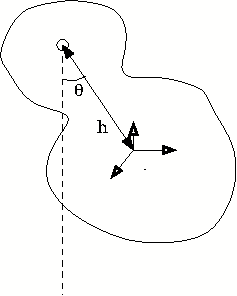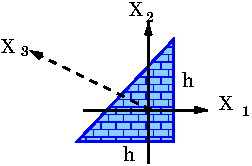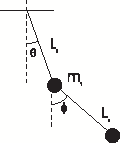|
|
[QUE/QFT-01]Node id: 3536page
- Write the Lagrangian for free Schrodinger field and obtain an expression for the Hamiltonian.
- Using the Poisson bracket form of equations of motion show that the Galilean boost \[\int d^3 x\psi^\dagger (m~x+ it \hbar \nabla)\psi,\] is a conserved quantity. How do you interpret this conservation law?
|

|
22-04-07 20:04:30 |
n |
|
|
[QUE/QM-11013]Node id: 3538pageGiven Galilean transformations \begin{equation} \vec{x} \longrightarrow \vec{x}\,^\prime = \vec{x} + \vec{v} t \end{equation} and \begin{equation} \psi(\vec{x}) \longrightarrow \psi\,^\prime(\vec{x}\,^\prime) = e^{-im\vec{v}\,^{\prime\,2} t/(2\hbar)} e^{im\vec{v}\cdot\vec{x}/\hbar} \psi(\vec{x}). \end{equation} show that these are a symmetry transformations of
the time dependent Schrodinger equation.
|

|
22-04-07 19:04:01 |
n |
|
|
[QUE/QFT-02] Node id: 3537pageCompute infinitesimal variations of the Lagrangian density for the Schrodinger field under the Galilean transformation \begin{equation} \vec{x} \longrightarrow \vec{x}\,^\prime = \vec{x} + \vec{v} t \end{equation} and \begin{equation} \psi(\vec{x}) \longrightarrow \psi\,^\prime(\vec{x}\,^\prime)
= e^{-im\vec{v}\,^{\prime\,2} t/(2\hbar)} e^{im\vec{v}\cdot\vec{x}/\hbar}
\psi(\vec{x}).\end{equation}Verify that the the change in Lagrangian is a total time derivative. Find the corresponding constant of motion.
|

|
22-04-07 19:04:22 |
n |
|
|
[QUE/QFT-15013]Node id: 3545pageShow that the Rutherford scattering cross section for a second quantized Dirac particle in an external Coulomb field \((Ze^2/r)\) is given by \begin{equation}
\frac{d\sigma}{d\Omega} = \frac{Z^2\alpha^2(1-v^2\sin^2(\theta/2))}{4|\vec{k}|^2 v^2 \sin^4(\theta/2)}.\end{equation}
where \(\vec{k}\) is the momentum of the incident particle and \(\theta \) is the angle of scattering.
|

|
22-04-07 19:04:31 |
n |
|
|
[QUE/CM-01001] Periodic Motion \(V(x)=A|x|^n\) (With Solution)Node id: 1907pageQuestion : A particle moves in a force field given by the potential $V(x) = A |x|^n $ Find the time period as function of energy.
Answer: $T= \left\{\displaystyle {2\over n}\sqrt{2m\pi\over E} {\left(E\over A\right)^{1/n}{\Gamma(1/n)\over \Gamma({n+2\over 2n})}}\right\}$
|

|
22-04-07 19:04:44 |
n |
|
|
[QUE/CM-01002] Periodic Motion \(V(x)=-V_0\text{sech}^2 x\) poetntial (with Solution)Node id: 1908pageQuestion : For a particle moving in a potential well $$\displaystyle V(x) = -V_0\,\text{sech}^2(\alpha x),\qquad -V_0 < E < 0$$ find the time period as a function of energy of the particle.
Answer : $ \displaystyle ({\pi\over \alpha})\sqrt{(2m/|E|)}$
|

|
22-04-07 19:04:01 |
n |
|
|
[QUE/QFT-13001]Node id: 2297page\(\newcommand{\ket}[1]{|#1\rangle}\newcommand{\matrixelement}[3]{\langle#1|#2|#3\rangle} \)
Use Wick's theorem to evaluate and calculate the following free field time ordered operator product \[\matrixelement{0}{T\big(\phi(x_1)\phi(x_1)\phi(x_1)\phi(x_2)\phi(x_3)\phi(x_4)\phi(x_5)\phi(x_6)\phi(x_7)\big}{0 }\]
Here \(\phi(x)\) represents free scalar field.
|

|
22-04-07 19:04:25 |
n |
|
|
[QUE/QFT-11] Feynman PropagatorNode id: 3675page |

|
22-04-07 19:04:00 |
n |
|
|
[QUE/QM-06009]Node id: 1997page A particle in a one dimensional box of size L with potential given by
\begin{eqnarray*} V(x) = \left\{ \begin{array}{ll}
0 & 0 \le x \le L \\ \infty & \mbox{otherwise}
\end{array} \right. \end{eqnarray*} has the wave function
$$\psi_0(x) = A x(x-L) $$ What is the probability that the particle will have energy $E_n$ $$ E_n = {n^2\pi^2\hbar^2\over 2mL^2} ?$$
|

|
22-04-07 19:04:04 |
n |
|
|
[QUE/ME-14001]Node id: 3269page
| A point of rigid body is pivoted in way that the body can rotate freely about a horizontal axis passing thorough the point of suspension. Show that the frequency of small oscillations is given by \[\omega^2= \frac{Mgh}{Mh^2 + I_1n_1^2+I_2n_2^2+I_3n_3^2}\] where \(I_1, I_2, I_3\) are principal moments of inertia about the centre of mass and \(h\) is distance of centre of mass from the point of suspension. |
 |
Landau
|

|
22-04-07 19:04:35 |
n |
|
|
[QUE/ME-14003]Node id: 3271page
| Show that the moment of inertia tensor of a uniform triangular plate, see figure, with centre of mass chosen as origin is given by \begin{equation} I= \frac{mh^2}{18} \begin{pmatrix} 1 & -\frac{1}{2} & 0\\ -\frac{1}{2} & 1 & 0\\ 0 & 0 & 1 \end{pmatrix}\end{equation} |
 |
|

|
22-04-07 19:04:34 |
n |
|
|
[QUE/ME-14004]Node id: 3272page
| Three equal masses, connected by light rods, are placed at the vertices of a right angle triangle as shown in figure. The origin of the coordinate system is chosen to coincide with the centre of mass of the system. Obtain the values of moment of inertia tensor components. |
 |
|

|
22-04-07 18:04:27 |
n |
|
|
[QUE/ME-14005]Node id: 3281page
| Find the moment of inertia tensor of a uniform rectangular plate w.r.t. the centre \(O\) of the plate relative to the axes \(K\) shown in figure. Use parallel axes theorem to find moment of inertia tensor relative to a set of axes \(K_2\) with origin taken as the corner \(E\). The \(Z\)- axis for both systems is perpendicular to the plate and out of the plane of paper. |
 |
|

|
22-04-07 18:04:54 |
n |
|
|
[QUE/ME-08005]Node id: 3283page
A cart carries an air ballon suspended from ceiling and a He filled balloon tied to the floor. The figure shows the situation when the cart is moving with uniform velocity. How will the two ballons appear when the cart has an non zero acceleration in the forward direction indicated in the figure by an
arrow? |
 |
 |
|

|
22-04-07 18:04:31 |
n |
|
|
[QUE/CM-01021]Node id: 2433page
| A chain of length $L$ is released from rest in the position shown with barely enough hanging links to initiate the motion. The coefficient of friction between the links and the horizontal surface is $\mu$. Neglecting the friction at the corner, determine the velocity $V$ of the chain when the last link leaves the edge. |
 |
( Sommerfeld)
|

|
22-04-07 18:04:41 |
n |
|
|
[QUE/CM-02001]Node id: 2534page
A double pendulum consists of two masses $m_1$ and $m_2$ connected to light bars of lengths $l_1$ and $l_2$ as shown in Fig.1 below.
- Set up the Lagrangian for the double pendulum.
- Derive Lagrange's equations of motion for the double pendulum.
|
 |
|

|
22-04-07 18:04:29 |
n |
|
|
[NOTES/QCQI-03001] Entanglement Node id: 5026page |

|
22-04-07 13:04:41 |
n |
|
|
[NOTES/QCQI-03002] Density MatrixNode id: 5027page |

|
22-04-07 13:04:50 |
n |
|
|
[NOTES/QCQI-03003] Density Matrix of Mixed State Node id: 5028page$\newcommand{\average}[2]{\langle#1|#2|#1\rangle}$
|

|
22-04-07 13:04:02 |
y |
|
|
[NOTES/QCQI-01005] Bloch Sphere Node id: 5022page |

|
22-04-07 13:04:01 |
y |